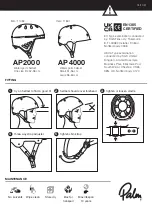
Please refer to www.coopercontrol.com under the Legal section for our terms and conditions.
Issue
Possible Causes
Suggestions
Lights
Will Not
Turn ON
automatically
Daylight Feature Enabled
If all lights are required to turn ON adjust
daylight potentiometer
Power interruption
Check incoming voltage and/or wiring
If lights will still not turn ON, set sensor to override mode and call Technical Services at 1-800-553-3879
Lights
Will Not
Turn OFF
automatically
Override
Make sure sensor is not in Override Mode (DIP Switch 8 up).
Sensor installed close to an air vent
Sensors should be installed minimum 4 - 6 feet away from
any air vent and out of path of heavy airflow.
Sensor installed close to indirect lighting.
Sensors should be mounted away from indirect lighting.
Self-adjust
It may be possible for the unit to have self-adjusted the time
delay to a 30 minute delay. If the lights do not turn OFF after
30 minutes follow next step.
30 Minute Delay
Maximum time delay is 30 Minutes. Check DIP Switches to
verify DIP Switch settings. If lights do not turn OFF at the set
time delay, check next step.
Ultrasonic Sensitivity set High
Lower sensitivity by turning green potentiometer CCW in
small decrements.
PIR activated by heat source other than occupant
Move DIP Switch 5 up
If lights will still not turn OFF, call Technical Services at 1-800-553-3879
LED Indicators Functionality
Adjustments should be made with the HVAC system ON. Use only insulated tools to make adjustments.
Self-Adjust
Sensor is shipped in the Self-Adjust Mode. This applies to time delay, US and PIR sensitivity. In preparation for the
Installer Test, the time delay is set to 15 seconds, after the sensor is installed, powered ON and has stabilized, the
unit will time-out 15 seconds after the last motion detected. Coverage and sensitivity can be confirmed by watching
the Green (US) and Red (PIR) indicator LEDs on the front of the sensor, while moving around the room.
1. Walk around the room and monitor LEDs. LEDs should flash every ¼ second with each motion. (If LEDs do not
turn ON, go to Installer Adjustments - Sensitivity Adjustments Section)
2. Stand still six to eight feet away from the sensor for five seconds. LEDs should not turn ON. (If any LED turns
ON, note LED and go to Installer Adjustments – Sensitivity Adjustment section)
3. Walk outside the room and wait 15 seconds for the lights to turn OFF. (If lights do not turn OFF go to Installer
Adjustments Section)
4. Re-enter the room to activate sensor. (If lights do not turn ON go to Troubleshooting Section)
5. The unit will remain in Test Mode for 10 minutes then automatically exit Test Mode and go into the 10 minute
Time Delay User Mode setting.
Note:
To place into Test Mode, toggle DIP switch 10 out of its current position, wait 3 seconds, and then back in to its original position. To force into 10 min
User Mode move Dip switches 1 and 2 down. (If DIP switches 1 and 2 are already down, toggle DIP switch 1 out of its current position, wait 3 seconds, and
then back to its original position) While in Test Mode, the LEDs will flash once per 1/4 second.
Sensitivity Adjustments
Ultrasonic Sensitivity
(Green LED) – Using a small flathead screw driver turn the green potentiometer so that the arrow
points up.
1. Stand in different areas of the room and wave your hands.
2. If the Green LED does not turn ON, increase the US sensitivity by turning the green potentiometer clockwise in
small increments. Repeat Step 1.
3. Stand still six to eight feet away from sensor for five seconds. LED should not turn ON.
4. If Green LED turns ON without motion or is constantly ON decrease the US sensitivity by turning the Green
potentiometer counter-clockwise in small decrements. Repeat Step 3.
PIR Sensitivity
1. Stand in different areas of the room and wave your hands.
2. If the Red LED does not turn ON, check for any obstructions.
3. Stand still six to eight feet away from sensor for five seconds. LED should not turn ON.
4. If Red LED turns ON without motion or is constantly ON adjust PIR sensitivity to 50% by moving DIP switch 5 up.
Field-of-view outside the space
1. Adjust PIR sensitivity to 50% by moving DIP Switch 5 up.
2. Adjust Ultrasonic Sensitivity.
Daylight Adjustments (0 to 300 foot-candles)
If this feature is not needed, leave the light level at maximum (fully clockwise).
The Daylighting feature prevents the lights from turning ON when the room is adequately illuminated by natural light. If
there is enough light in the room regardless of occupancy, the sensor will hold the lights OFF. If there is not enough light
in the room, the sensor will allow the lights to turn ON when occupied. However the lights will not turn OFF if the light level
goes above the preset value as per the daylight potentiometer.
Note:
Set the light level when the ambient light is at the level where no artificial light is needed.
1. With the load ON, put the sensor into Test Mode. To place into Test Mode, toggle DIP Switch 10 out of its current
position, wait 3 seconds and then back in to its original position.
2. Set DIP Switch 10 to Relay Two Only or Relay One and Two.
3. Set the Light level to Minimum (fully CCW).
4. Leave the room and let the sensor Time-out so lights are OFF. Enter the space and lights should remain OFF.
5. Make sure not to block the sensor from the daylight source and adjust the light level potentiometer CW in small
increments until the lights are ON. (Pause 5 seconds between each adjustment)
6. Once the lights are ON, the load connected to the sensor will not turn ON if light levels are above the current
illumination.
Time Delay Adjustments
People who remain very still for long periods of time may need a longer time delay than the default setting of 10
minutes. As long as Auto is enabled, the sensor will respond to each pair of false-offs with no normal OFF in between, by
alternately making slight adjustments to either time delay (by 2 minute increments) or sensitivity, so there should be no
need for manual adjustment. If manual adjustment is desired, refer to Time Delay settings in DIP switch legend.
Reset sensor Time Delay to factory settings by moving DIP switches 1 and 2 down. (If DIP switches 1 and 2 are
already down, toggle DIP switch 1 out of its current position, wait 3 seconds, and then back to its original position)
Bathroom Mode (OAC-DT-2000-DMV Model Only)
When selected, bathroom mode keeps the second relay ON for an additional 10 minutes after the first relay has been
turned OFF.
Relay Swap (OAC-DT-2000-DMV Model Only)
A common problem in electric wiring is wiring the wrong wire to the wrong load. This can make control of loads
confusing to an end user. The Relay Swap option solves the problem by swapping the relays after the unit is wired and
installed.
Override
The Override setting allows the lights to remain ON in the unlikely event of sensor failure.
1. Move DIP Switch 8 up.
Not Used
Override
LEDs
(DMV model only)
Relay 2
Pot 1 - Blue (0-300 FC)
Ultrasonic
(-R model only)
Pot 2 - Green
Not Used
Daylighting
Relay 1 & 2
(DMV model only) (DMV model only)
Bathroom Mode
Relay Swap
1 2 3 4 5 6 7 8 9 10 11 12
ON
Daylight Sensor Adjustment
Ultrasonic Sensitivity Adjustment
Eaton’s Cooper Controls Business
203 Cooper Circle
Peachtree City, Georgia 30269
www.coopercontrol.com
Printed in Malaysia
DIP Switch Settings
Checkout and Adjustment
During Installer/Test Mode
While in User Mode
LED Flashing Speed
LEDs will flash once per ¼ second
LEDs will flash once per second
Duration
10 minutes
10 to 30 minutes
Installer Adjustments
Troubleshooting
Warranties and Limitation of Liability




















